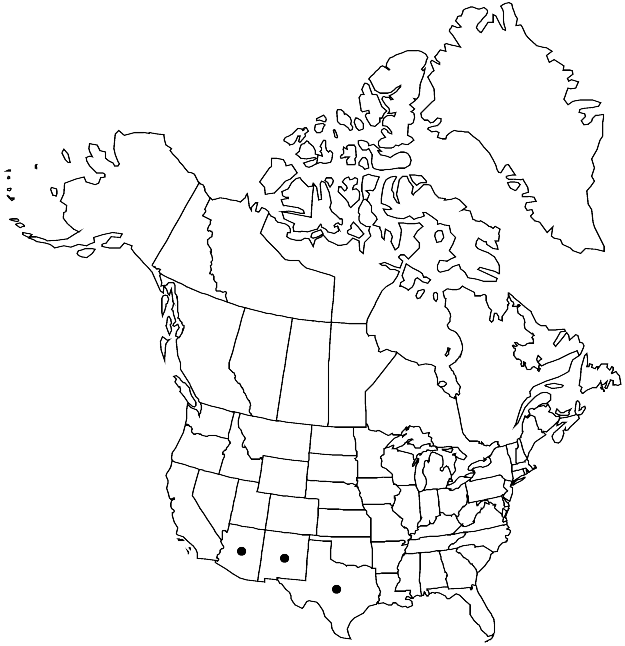Difference between revisions of "Streptanthus carinatus"
Smithsonian Contr. Knowl. 5(6): 11. 1853.
FNA>Volume Importer |
RevisionBot (talk | contribs) m (Bot: Adding category Revised Since Print) |
||
| (3 intermediate revisions by 2 users not shown) | |||
| Line 23: | Line 23: | ||
-->{{Treatment/Body | -->{{Treatment/Body | ||
| − | |distribution= | + | |distribution=Ariz.;N.Mex.;Tex.;n Mexico. |
|discussion=<p>Subspecies 2 (2 in the flora).</p><!-- | |discussion=<p>Subspecies 2 (2 in the flora).</p><!-- | ||
--><p>A. R. Kruckeberg et al. (1982) presented evidence for hybridization between <i></i>subsp.<i> carinatus</i> and <i></i>subsp.<i> arizonicus</i>, and showed that the lighter flower color in the latter correlates with degree of leaf division. Within the range of <i>Streptanthus carinatus</i>, four color forms are known: purple, white, ochroleucous, and yellow. Variability in petal color does not correlate with geography or habitat, and flowers are often poorly preserved on herbarium specimens, making it unclear whether the color forms are allopatric.</p> | --><p>A. R. Kruckeberg et al. (1982) presented evidence for hybridization between <i></i>subsp.<i> carinatus</i> and <i></i>subsp.<i> arizonicus</i>, and showed that the lighter flower color in the latter correlates with degree of leaf division. Within the range of <i>Streptanthus carinatus</i>, four color forms are known: purple, white, ochroleucous, and yellow. Variability in petal color does not correlate with geography or habitat, and flowers are often poorly preserved on herbarium specimens, making it unclear whether the color forms are allopatric.</p> | ||
| Line 54: | Line 54: | ||
|basionyms= | |basionyms= | ||
|family=Brassicaceae | |family=Brassicaceae | ||
| − | |distribution= | + | |distribution=Ariz.;N.Mex.;Tex.;n Mexico. |
|reference=None | |reference=None | ||
|publication title=Smithsonian Contr. Knowl. | |publication title=Smithsonian Contr. Knowl. | ||
|publication year=1853 | |publication year=1853 | ||
|special status= | |special status= | ||
| − | |source xml=https:// | + | |source xml=https://bitbucket.org/aafc-mbb/fna-data-curation/src/2e0870ddd59836b60bcf96646a41e87ea5a5943a/coarse_grained_fna_xml/V7/V7_1220.xml |
|tribe=Brassicaceae tribe Thelypodieae | |tribe=Brassicaceae tribe Thelypodieae | ||
|genus=Streptanthus | |genus=Streptanthus | ||
| Line 65: | Line 65: | ||
}}<!-- | }}<!-- | ||
| − | -->[[Category:Treatment]][[Category:Streptanthus]] | + | --> |
| + | |||
| + | [[Category:Treatment]] | ||
| + | [[Category:Streptanthus]] | ||
| + | [[Category:Revised Since Print]] | ||
Latest revision as of 18:13, 6 November 2020
Annuals or biennials; (glaucous), glabrous throughout. Stems branched basally and/or distally, (2.1–)3–6.5(–7.5) dm. Basal leaves rosulate; petiolate; blade pinnatifid or oblanceolate, 3.5–15(–30) cm, margins runcinate-pinnatifid, dentate, or entire. Cauline leaves: blade ovate to lanceolate, 2.5–14 cm × 4–55 mm, (smaller distally), base auriculate to amplexicaul, margins runcinate-pinnatifid, dentate, or entire (usually entire distally). Racemes ebracteate, (lax). Fruiting pedicels divaricate-ascending, (straight or curved upward), 7–22(–35) mm. Flowers: calyx urceolate or campanulate; sepals purple, or ochroleucous to yellowish, 8–11 mm, keeled; petals white (with purplish veins) or purple (with white margins, recurved), 14–18 mm, blade 5–8 × 1–1.5 mm, margins crisped, claw 9–12 mm, about as wide as blade; stamens in 3 unequal pairs; filaments (distinct): abaxial pair 6–10 mm, lateral pair 4–7 mm, adaxial pair (exserted), 9–12 mm; anthers (all) fertile, 4–5 mm; gynophore 0.5–2 mm. Fruits ascending, smooth, straight, strongly flattened, 3–8 cm × 4.5–6 mm; valves each with obscure midvein; replum straight; ovules 26–54 per ovary; style 0.5–2 mm; stigma strongly 2-lobed. Seeds orbicular, 3–5 mm diam.; wing 0.6–1.1 mm wide, continuous. 2n = 28.
Distribution

Ariz., N.Mex., Tex., n Mexico.
Discussion
Subspecies 2 (2 in the flora).
A. R. Kruckeberg et al. (1982) presented evidence for hybridization between subsp. carinatus and subsp. arizonicus, and showed that the lighter flower color in the latter correlates with degree of leaf division. Within the range of Streptanthus carinatus, four color forms are known: purple, white, ochroleucous, and yellow. Variability in petal color does not correlate with geography or habitat, and flowers are often poorly preserved on herbarium specimens, making it unclear whether the color forms are allopatric.
Selected References
None.
Key
| 1 | Basal and proximal cauline leaf blades: margins runcinate-pinnatifid; sepals purple; petals purple with white margins. | Streptanthus carinatus subsp. carinatus |
| 1 | Basal and proximal cauline leaf blades: margins entire, dentate, or runcinate-pinnatifid; sepals ochroleucous to yellowish; petals white with purplish veins. | Streptanthus carinatus subsp. arizonicus |